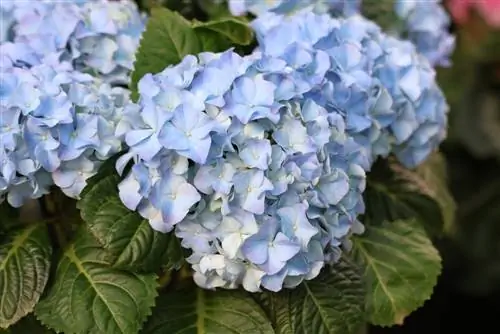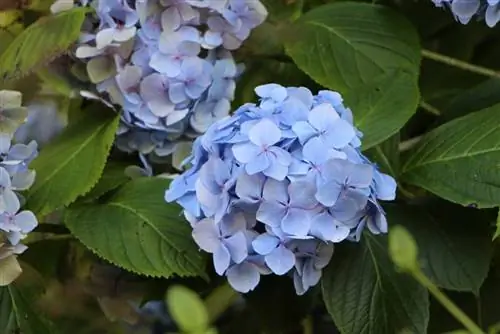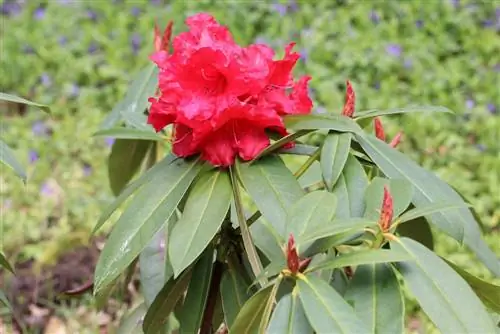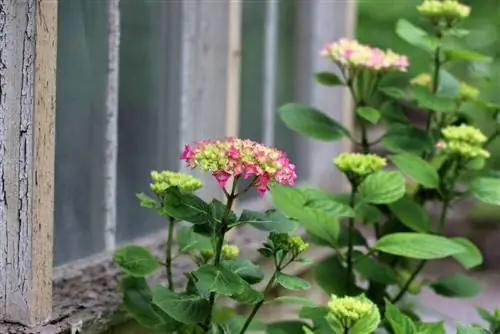- Author admin [email protected].
- Public 2023-12-17 03:39.
- Last modified 2025-01-24 12:45.
Flowers of hydrangeas, rhododendrons or hibiscus are decorative, which is why the plants are often cultivated in gardens. However, there has been a rumor going around for some time that these flowers act like marijuana when smoked. But this is dangerous misinformation because the flowers are highly poisonous, especially when smoked.
Contains poison hydrangeas
Hydreneas are often picked and smoked as a marijuana substitute, especially by young people. But the substances they contain can become very dangerous if consumed in large quantities. The following poison is contained in hydrangeas:
- Prussic acid
- Hydrangine
- Hydrangenol
- Saponins
While the hydrogen cyanide, when ingested, ensures that the red blood cells are destroyed and therefore no more oxygen is transported, the ingestion of other toxins causes anxiety and dizziness. Especially for sensitive people, this can lead to a threatening state of intoxication which, however, has nothing in common with the intoxication caused by marijuana or hashish consumption.
Poisoning symptoms
If the flowers of hydrangeas are deliberately smoked, several are needed. This means that consumption is not accidental and there is a higher concentration of poisons absorbed when the smoke is inhaled into the lungs. From here the toxins enter the bloodstream and can even cause life-threatening symptoms:
- Suffocation attacks
- Cramps
- Unconsciousness
- rosy skin
- Heart racing
- Vertigo
- feelings of oppression
The effect of smoking hydrangeas is therefore not a feeling of intoxication, as is caused by consuming cannabis, for example, but simply a dangerous lack of oxygen, as the oxygen is no longer passed on in the blood. Because the plant does not contain any substances that have a hallucinogenic effect.
Tip:
Especially people who are allergic to the poisons contained in them even after slight contact are particularly at risk if they smoke the flowers. However, such a contact allergy is usually hidden and those affected usually do not know anything about it. Therefore it can be particularly dangerous in such a case.
Long-term consequences
So far there is little information about the long-term consequences. But the theoretical consequences can range from loss of consciousness to disruption of the central nervous system and even death from heart failure. This is mainly due to the hydrogen cyanide it contains, which causes a lack of oxygen in the blood.
Tip: If the symptoms are recognized in a person, the emergency doctor should be called immediately for help. A call to the poison control center can also be helpful for initial measures. A person who has smoked hydrangeas or rhododendrons should seek medical attention immediately, no matter how severe the symptoms are at the moment.
Smoking rhododendron flowers
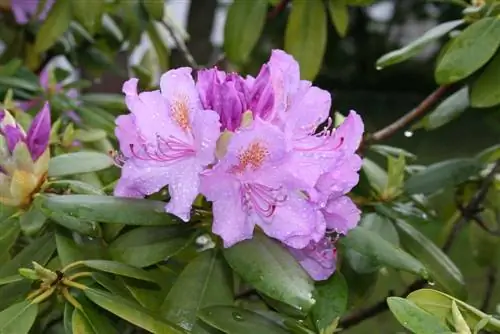
Rhododendron plants are grown primarily in China, Tibet and Nepal for the purpose of obtaining intoxicants. Here it is customary to chew, sniff or smoke the parts of the plant. But the rhododendron is also dangerous for us humans because of its toxicity, especially if it is absorbed into the body, in whatever way. The honey from the rhododendron flowers should also be enjoyed with caution, as it is also often used as a so-called intoxicant. The usage in Asian countries looks like this:
- dried flowers, stems and leaves are smoked
- Bark and leaves are used as tobacco
- Tobacco can be sniffed, smoked or chewed
If you only consume a little of the tobacco, you will appear as intoxicated as someone who is very drunk, according to Chinese teachings. However, if too much tobacco is consumed, it can be dangerous and even fatal.
Tip:
Drugs are never a solution and especially rhododendron and hydrangea flowers, which contain poisons, should definitely be avoided for your own he alth, even if they are inexpensive.
Poison Rhododendron
The rhododendron is poisonous in all parts, especially the leaves and flowers as well as pollen. The toxic substances proven to contain are the following:
- Diterpenes
- Grayanotoxins
- Acetylandromedol
- Tannin
- added to this are various essential oils
Just a single flower or leaf can cause severe symptoms if accidentally consumed. If these are even absorbed into the lungs via the smoke, then it can become very dramatic and dangerous.
Tip:
In China, ginger is given to combat the symptoms of poisoning caused by eating rhododendrons. However, it has not been further proven whether this has the desired success. Therefore, an emergency doctor should always be consulted if symptoms occur.
Symptoms
If the poison from the rhododendron was absorbed through the smoke, then the following symptoms may occur, which should not be taken lightly, especially if many flowers or leaves were smoked in a row:
- Skin tingling
- Irritation of the mucous membrane
- Diarrhea
- Vomiting
- Vertigo
- slow heartbeat
- Cardiac arrhythmias
- Respiratory paralysis
Especially the dizziness that can occur when poisoning suggests to the consumer that there is an intoxicating effect, which, however, is not the case. Because the rhododendron only contains poisons, but no intoxicants that could be equated with marijuana or hashish consumption.
Hibiscus poisonous?
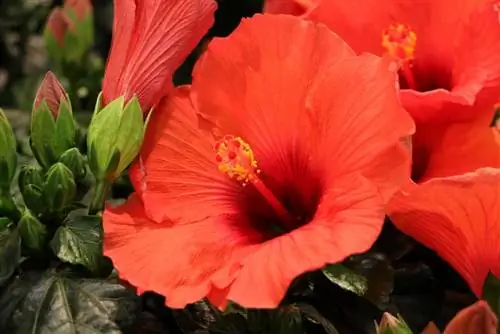
Neither the leaves, the flowers nor the entire hibiscus plant are poisonous. Therefore, of course, all parts of the plant can be used and smoked as tobacco. However, there will be no intoxicating effects, nor can the smoker poison himself from the smoke, causing dizziness or other problems. Hibiscus is therefore completely harmless, but is not used as a drug substitute.
Sources:
www.gizbonn.de
hanfjournal.de

